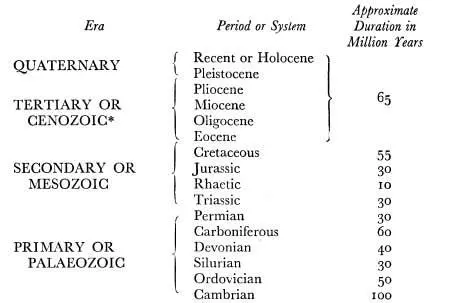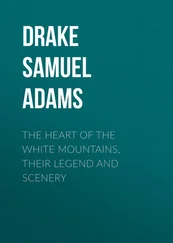The layman is constantly demanding to be told the age of a given bed in years and amongst geologists themselves the age of the earth has always been a fascinating subject.

FIG. 4.—The Geological Column with the names of the geological periods and an approximate time scale in years.
One ingenious calculation worked out the amount of dissolved salts carried down to the sea every year by the rivers of the world and consequently how long it would have taken the ocean, presuming the water of the ocean to have been fresh originally, to have reached its present degree of salinity. A rough method at best, it breaks down as there is no evidence that the waters of the world ocean were originally fresh. In recent years a method of estimating geological time in years has been devised and used with considerable success. There are certain elements—the radioactive elements—which undergo disintegration at a constant but very slow rate which can be and has been measured. When a minute crystal of a radioactive mineral is enclosed in a larger crystal of certain other minerals—such as the dark mica, biotite—the emanations from the radioactive mineral cause a visible change in the surrounding mineral. When studied in section under the microscope the size of the zone of alteration, or “pleochroic halo,” affords a means of measurement of the time which has elapsed since the original formation of the rock. Another method is by the very accurate chemical analysis of the unaltered radioactive substance proportionate to the amount of the final end-products of its disintegration.
Piecing together the evidence, the geological column and the approximate duration of each period are in Fig. 4.
The names of the periods are reminders both of the richness of the British Isles in its varied geology where all the great systems are represented and also of the pioneer part played by British scientists in the geological field. The Cambrian takes its name from Cambria or Wales; the Ordovician and Silurian from two tribes of ancient Britons who lived on the Welsh borderland where these rocks are well developed and where they were first described. The name Devonian is from the county of Devon. Permian is a name which honours the pioneer studies of the British geologist Murchison in the province of Perm at the request of the Russians. Carboniferous (carbon- or coal-bearing) and Cretaceous (chalky) are descriptive of British conditions whilst the names of the divisions of the Tertiary are reminders of the Greek scholarship of Charles Lyell and his followers. The Jurassic (Jura Mountains) combines the older English Lias and Oolites; the Trias takes its name from the three-fold division typical of that system in Germany. Only the Rhaetic (Rhaetic Alps) is poorly represented in Britain. The Quaternary is not really comparable in duration or importance with the other great eras.

The coal-bearing strata of the Coal Measures form the upper division of the Carboniferous.
* Often written Cainozoic or Kainozoic.
EARTH HISTORY—TIME AND LIFE
WE ARE fortunately living in one of the quiet periods of the earth’s history, though not at a time when it has been quiet for so long that the surface has been worn down to a dull and monotonous level. Although the accurate instrumental observation of earthquake phenomena demonstrates that the earth’s crust is rarely absolutely still, the occasional earthquakes which do occur, however severe they may be, are in reality but very gentle reminders of those periods in the history of the earth when the whole surface must have been torn by the most violent and long-continued cataclysms which bent and folded and broke the hardest rocks; which caused whole blocks of the earth’s crust to be thrust many scores of miles over other blocks; which caused continents to sink below the waves of the sea, or which caused vast tracts of the ocean bed to be raised to form the world’s highest mountains. The earthquakes of to-day are like the final murmurs of a great storm which has passed. Even they tend to occur in certain defined earthquake belts and are reminders that the earth’s crust has certain lines and zones of weakness whereas other parts are relatively stable.
If we exclude the great mountain-building movements which took place in the dim early days of the earth’s history—in the Pre-Cambrian—there have been three great periods of mountain building or “orogenesis” (Greek, oros mountain; genesis origin, creation) as far as Europe is concerned. Each of these has played a major part in determining the present-day features of Britain. These three great mountain-building periods were:
( a ) at the end of the Silurian and beginning of the Devonian periods—the Caledonian earth-movements, so called because they built up the great mountains which have since been worn down to form the Highlands of Scotland (Caledonia);
( b ) at the end of the Carboniferous and beginning of the Permian periods—the Armorican or Hercynian earth-movements, so called because they caused the great folding of the rocks seen in Brittany (Armorica) and the Hartz Mountains of Germany. In Britain they caused the uplift of the Pennines, the Malvern and Mendip Hills and folded the Coal Measures into basins.
( c ) in the middle of the Tertiary era—the Alpine earth-movements, so called because they were responsible for the rise of the Alps as well as of many of the great mountain chains of the world to-day but which affected Britain much less than the previous movements.
Of the still earlier earth-movements at least one left very important marks in Britain—the Lewisian, which caused the folds in the rocks in the extreme north-west of Scotland and which may have been contemporary with the folding of the ancient rocks which peep from beneath a cover of later strata in the Charnwood Forest of Leicestershire.
In each case the mountain-building movements gathered strength slowly as with a developing storm and gradually reached a peak when the whole earth must have experienced a constant succession of gigantic earthquakes. Then gradually they must have died away again, the whole cycle stretching over an immense period of time. The result of these earth-building or orogenic movements was to form a series of gigantic wrinkles in the crust of the earth—these are the main mountain chains—between which are broad areas but little disturbed—the “tectonic” basins (Greek: tektonikos, related to building—i.e. not formed by later excavation. Sometimes these basins were below sea-level and became the areas of sedimentation in the succeeding periods, while the surrounding mountains as soon as formed were attacked by the forces of denudation which started to wear them down. So we get the idea of the geological history of the earth moving in great cycles. The first is what may be called the major cycle of denudation. This may be considered to begin when earth movements have caused land to rise above the level of the waters in the surrounding ocean. No sooner does this happen than the forces of sub-aerial denudation get to work. The heat of the sun heats the rocks and the different minerals of which they are composed have differential rates of expansion so that, especially with nightly cooling, the rocks are disrupted and a peeling or exfoliation (Latin: folium, a leaf) by successive layers takes place. This is sometimes called onion weathering and is well seen in hot dry countries at the present day. The direct action of the sun is called insolation.
Читать дальше














